工程热力学与传热学(双语)第9章习题课
- 格式:ppt
- 大小:341.00 KB
- 文档页数:9
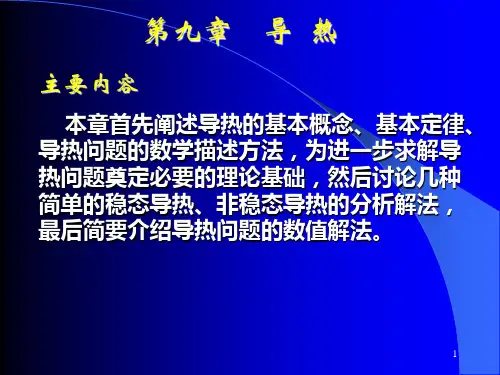
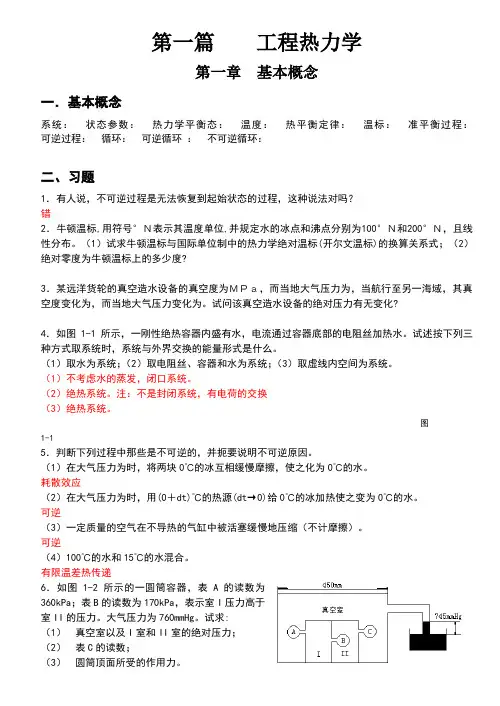
第一篇工程热力学第一章基本概念一.基本概念系统:状态参数:热力学平衡态:温度:热平衡定律:温标:准平衡过程:可逆过程:循环:可逆循环:不可逆循环:二、习题1.有人说,不可逆过程是无法恢复到起始状态的过程,这种说法对吗?错2.牛顿温标,用符号°N表示其温度单位,并规定水的冰点和沸点分别为100°N和200°N,且线性分布。
(1)试求牛顿温标与国际单位制中的热力学绝对温标(开尔文温标)的换算关系式;(2)绝对零度为牛顿温标上的多少度?3.某远洋货轮的真空造水设备的真空度为MPa,而当地大气压力为,当航行至另一海域,其真空度变化为,而当地大气压力变化为。
试问该真空造水设备的绝对压力有无变化?4.如图1-1所示,一刚性绝热容器内盛有水,电流通过容器底部的电阻丝加热水。
试述按下列三种方式取系统时,系统与外界交换的能量形式是什么。
(1)取水为系统;(2)取电阻丝、容器和水为系统;(3)取虚线内空间为系统。
(1)不考虑水的蒸发,闭口系统。
(2)绝热系统。
注:不是封闭系统,有电荷的交换(3)绝热系统。
图1-15.判断下列过程中那些是不可逆的,并扼要说明不可逆原因。
(1)在大气压力为时,将两块0℃的冰互相缓慢摩擦,使之化为0℃的水。
耗散效应(2)在大气压力为时,用(0+dt)℃的热源(dt→0)给0℃的冰加热使之变为0℃的水。
可逆(3)一定质量的空气在不导热的气缸中被活塞缓慢地压缩(不计摩擦)。
可逆(4)100℃的水和15℃的水混合。
有限温差热传递6.如图1-2所示的一圆筒容器,表A的读数为360kPa;表B的读数为170kPa,表示室I压力高于室II的压力。
大气压力为760mmHg。
试求:(1)真空室以及I室和II室的绝对压力;(2)表C的读数;(3)圆筒顶面所受的作用力。
图1-2第二章 热力学第一定律一.基本概念功: 热量: 体积功: 节流:二.习题1.膨胀功、流动功、轴功和技术功四者之间有何联系与区别? 2.下面所写的热力学第一定律表达是否正确?若不正确,请更正。

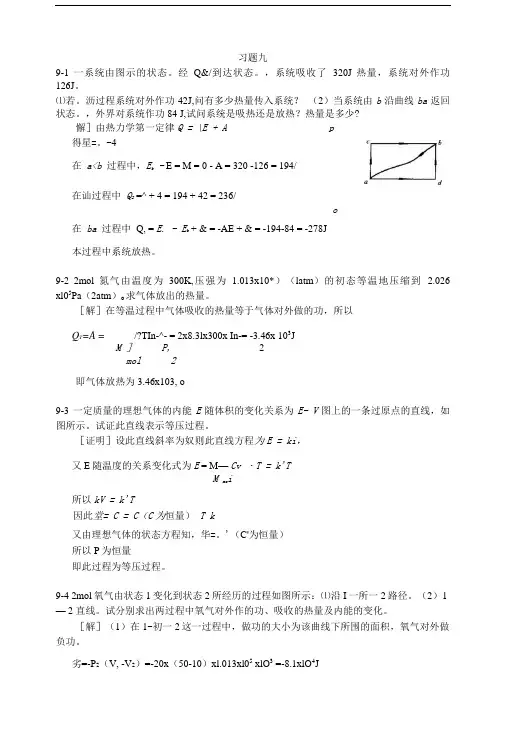
习题九9-1 一系统由图示的状态。
经Q&/到达状态。
,系统吸收了320J热量,系统对外作功126J。
⑴若。
沥过程系统对外作功42J,问有多少热量传入系统?(2)当系统由b沿曲线ba返回状态。
,外界对系统作功84 J,试问系统是吸热还是放热?热量是多少?懈]由热力学第一定律Q = \E + A p得星=。
-4在a<b过程中,E b - E = M = 0 - A = 320 -126 = 194/在讪过程中Q2 =^ + 4 = 194 + 42 = 236/o在ba过程中Q, = E. - E b + & = -AE + & = -194-84 = -278J本过程中系统放热。
9-2 2mol氮气由温度为300K,压强为 1.013x10*)(latm)的初态等温地压缩到 2.026 xl05Pa(2atm)o求气体放出的热量。
[解]在等温过程中气体吸收的热量等于气体对外做的功,所以Q T=A=/?TIn-^- = 2x8.3lx300x In-= -3.46x 103JM ]P,2mol 2即气体放热为3.46x103, o9-3 一定质量的理想气体的内能E随体积的变化关系为E- V图上的一条过原点的直线,如图所示。
试证此直线表示等压过程。
[证明]设此直线斜率为奴则此直线方程为E = ki,又E随温度的关系变化式为E = M—Cv ・T = k'TM mo i所以kV = k'T因此堂= C = C(C为恒量)T k又由理想气体的状态方程知,华=。
'(C'为恒量)所以P为恒量即此过程为等压过程。
9-4 2mol氧气由状态1变化到状态2所经历的过程如图所示:⑴沿I一所一2路径。
(2)1 — 2 直线。
试分别求出两过程中氧气对外作的功、吸收的热量及内能的变化。
[解](1)在1-初一2这一过程中,做功的大小为该曲线下所围的面积,氧气对外做负功。
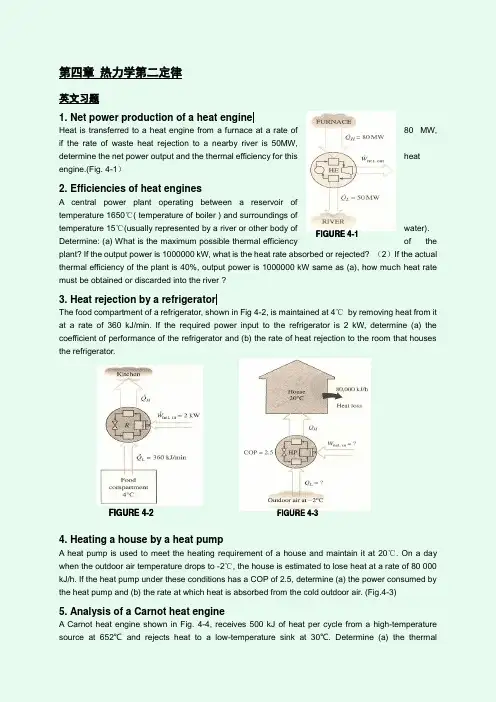

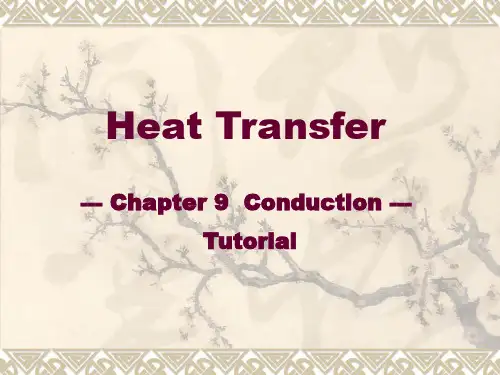
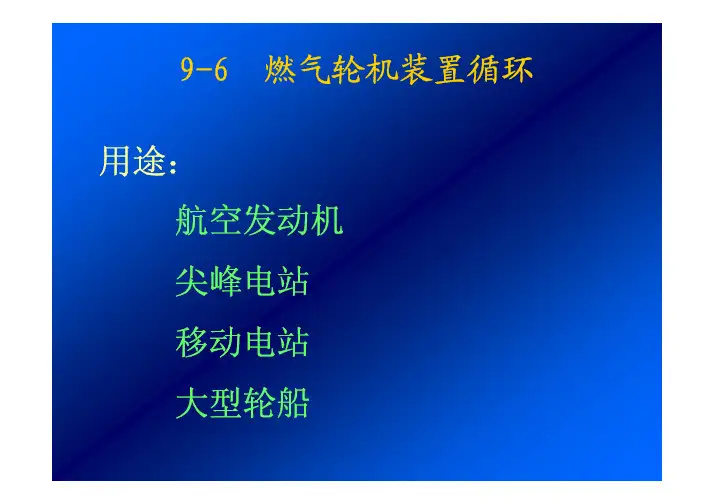
9-6 燃气轮机装置循环用途:航空发动机尖峰电站移动电站大型轮船燃气轮机装置燃气轮机的利用燃气轮机装置简介燃气轮机示意图和理想化(布雷顿循环)23燃烧室工质:数量不变,定比热理想气体2)闭口⇒3)布雷顿循环(Brayton Cycle )图示s12341234布雷顿循环的计算Ts1234吸热量:()1p 32q c T T =−放热量:()2p 41q c T T =−热效率:12241t 1113211w q q q T T q q q T T η−−===−=−−布雷顿循环热效率的计算s1234热效率:t 12111k kp p η−=−⎛⎞⎜⎟⎝⎠循环增压比21p p π=111k kπ−=−πtηktη布雷顿循环净功的计算s1234循环增温比31T T τ=()()324134211111p p p w c T T c T T T T T c T T T T =−−−⎛⎞=−−+⎜⎟⎝⎠净1111k k k kp c T ττππ−−⎛⎞=−−+⎜⎟⎝⎠对净功的影响s123431T T τ=1111k k kkp w c T ττππ−−⎛⎞=−−+⎜⎟⎝⎠净3’4’当不变π不变τw 净但T 3 受材料耐热限制111t k kηπ−=−τ对净功的影响s31T T τ=1111k k kkp w c T ττππ−−⎛⎞=−−+⎜⎟⎝⎠净当不变τ太大πw 净π3T 太小πt ηt ηw 净存在最佳,使最大πw 净111t k kηπ−=−1T最佳增压比(w 净)的求解s1111k k kkp w c T ττππ−−⎛⎞=−−+⎜⎟⎝⎠净令opt π3T 2(1)opt ()k k w πτ−=净1T 0w π∂=∂净最大循环净功()211opt p w c T τ=−9-7 燃气轮机装置的定压加热实际循环s1234压气机:绝热压缩燃气轮机:绝热膨胀2’4’'21c 12h h h h η−=−定义:'34oi 34h h h h η−=−燃气轮机的实际循环的净功Ts12342’4’()()'''314221oi 34cw h h h h h h h h ηη=−−−−=−−净净功吸热量''2113312ch h q h h h h η−=−=−−'21c 12h h h h η−=−'34oi 34h h h h η−=−'21c 12h h h h η−=−燃气轮机的实际循环的热效率s12342’4’1'''111111oik ckk c kw q τηηπητηπ−−−==−−−净t 热效率影响燃气机实际循环热效率的因素1'''111111oik ckk c kw q τηηπητηπ−−−==−−−净t·oi ηc η'tη·π一定,τ't η·τ一定,有最佳()'opt t πη·τ()'opt t πη右移和的关系()'opt tπη()'optw π净()'optw π净()'opt tπη()'opt wπ净tητπ受材料耐热限制取最佳()'opttπη有无其它途径2T 4T 4 500o C 1344p T 4>T 2回热一、回热9-8 提高燃气轮机装置循环热效率的措施布雷顿循环回热示意图234压气机燃气轮机燃烧室回热器4R2A回热在Ts 图上的表示21344R2R2A回热度2222A R h h h h σ−=−0.6~0.9t t 1w q ηη=>净回简2R 4R 2A压气机间冷的图示23燃气轮机燃烧室间冷器5压气机62’压气机间冷在Ts 图上的表示21342’65AB t 1w q η=净间1234162’256联合工作?压气机间冷热效率的推导A B tA 1A tB 1B t 1A 1B 1A 1B 1A 1B tA tB 1A 1B 1A 1Bw w q q q q q q q q q q q q ηηηηη++==++=+++净净间tA tBηη>tA tBt ηηη>>间tA tB ηη<tA tB t ηηη<<间tA tBηη=tA tBt ηηη==间间冷+回热示意图3燃气轮机燃烧室间冷器5压气机62’回热器4R 2R间冷+回热在Ts 图上的表示21342’65t t 1w q ηη=>净间+回简4R2R再热示意图23压气机燃气轮机燃烧室1燃烧室23’5再热在Ts 图上的表示2133’4’4t t ηη<再简w w >再简5结论:再热+回热示意图123压气机燃气轮机燃烧室2回热器燃烧室14R2R53’再热+回热在Ts图上的表示2 133’4’454R2R2t+t11qqηη=−>再回回w w>再+回回再热+间冷+回热示意图1234压气机燃气轮机燃烧室2回热器间冷器燃烧室12R4R结论:再热+间冷+回热在Ts 图上的表示3T s 214t t +1w q ηη=>净再+间+回再回t t t t ηηηη>>>再+间+回再+回回简w w w w >>=再+间+回再+回回简+w w >再+间+回再回2R4R无穷多级的极限情况2 13 4两个等温过程两个等压过程+回热概括性卡诺循环2~3第9章小结活塞式内燃机循环:燃气轮机循环:提高热效率的手段:t ηη=简124w 净1’2’0 w=净动力循环的一般规律:热能代价以作功为目的升压是前提加热是手段作功是目的放热是必须顺序不可变步骤不可缺。

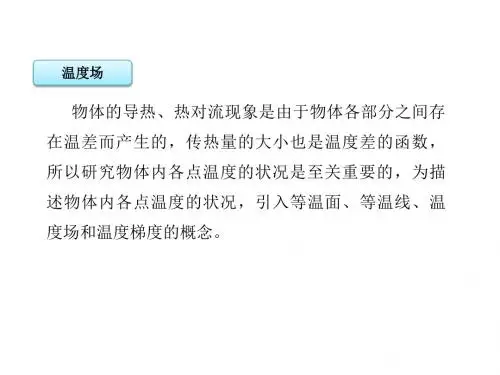

(完整版)《⼯程热⼒学》、《传热学》课程专业词汇中英⽂对照表《⼯程热⼒学》课程专业词汇中英⽂对照表thermodynamics热⼒学heat热work功irreversible process不可逆过程energylaw of energy conservation能量守恒定律temperature 温度thermal equilibrium热平衡Zeroth law of thermodynamics热⼒学第零定律temperature scale温标thermometer温度计thermodynamics scale of temperature 热⼒学温标density密度mass质量pressure压⼒gauge pressure表压absolute pressure绝对压⼒system系统boundary边界surrounding外界closed system闭⼝系统open system开⼝系统quantity of state状态参数process过程reversible process可逆过程irreversible process不可逆过程quasistatic process准静态过程isovolumetric process定容过程adiabatic process绝热过程isothermal process定温过程polytrophic process多变过程P-V diagram P-V 图absolute work 绝对功technical work技术功kinetic energy动能potential energy势能internal energy内能specific internal energy⽐内能specific heat capacity⽐热容constant volume specific heat capacity定容⽐热容constant pressure specific heat capacity定压⽐热容flow energy流动能enthalpy焓specific enthalpy⽐焓latent heat潜热sensible heat显热law of conservation of energy能量守恒定律first law of thermodynamics热⼒学第⼀定律nozzle喷管heat engine热机perpetual-motion machine of first kind第⼀类永动机ideal gas理想⽓体imperfect gas⾮理想⽓体equation of state状态⽅程式universal gas constant通⽤⽓体常数ratio of specific heat capacity⽐热容⽐Joule-Thomson effect焦⽿-汤姆逊效应partial pressure分压⼒Dalton”s law道尔顿定律humidity湿度dry air⼲空⽓absolute humidity 绝对湿度saturated steam pressure饱和蒸汽压relative humidity相对湿度dew point露点cycle循环reciprocating engine往复式发动机bottom dead center下⽌点top dead center 上⽌点thermal efficiency热效率refrigerator制冷机heat pump热泵72 irreversibility不可逆性second law of thermodynamic热⼒学第⼆定律Clausius statement克劳修斯表述Kelven-Plank statement 开尔⽂-普朗克表述perpetual-motion machine of second kind第⼆类永动机isenthalpic process定焓过程Carnot cycle卡诺循环Clausius integral克劳修斯积分Clausius inequality克劳修斯不等式entropy熵absolute entropy绝对熵principle of the increase of entropy熵增原理T-S diagram T-S图real gas实际⽓体steam蒸汽boiling 沸腾evaporation汽化saturation pressure饱和压⼒wet saturated steam 湿蒸汽convergent nozzle渐缩喷管critical pressure临界压⼒Mach number马赫数compression ignition engine压缩点⽕发动机Diesel cycle狄赛尔循环combined cycle混合加热循环gas turbine燃⽓轮机steam prime mover蒸汽原动机boiler锅炉《传热学》课程专业词汇中英⽂对照表heat transfer热传递heat conduction导热convection对流natural convection⾃然对流free convection ⾃由对流forced convection 强制对流heat transfer by convection对流换热phase change 相变evaporation蒸发boiling沸腾condensation凝结melting融化solidification凝固thermal radiation热辐射temperature field温度场steady-state conduction稳态温度场transient conduction⾮稳态温度场temperature gradient 温度梯度isotherms 等温线cartesian coordinates直⾓坐标系heat flux热流密度⽮量Fourier’s law导热基本定律heat Diffusion Equation导热微分⽅程式initial conditions初始条件boundary conditions边界条件thermal contact resistance接触热阻isothermal place等温⾯heat transfer rate热流量heat flux lines热流线heat flux热流密度thermal conductivity 导热系数thermal diffusivity热扩散率heat transfer coefficient换热系数thermal resistance热阻thermal resistance of fouling污垢热阻overall thermal resistance总热阻overall coefficient of heat transfer传热系数convection heat transfer对流换热dimensional analysis量纲分析boundary layer边界层analysis of the order of magnitude in boundary layer边界层的数量级分析boundary layer integral equation 边界层积分⽅程boundary layer differential equation边界层微分⽅程boundary grid point边界节点boundary layer condition边界条件turbulent flow湍流Nusselt number努谢尔特数Reynolds number 雷诺数Prandtl number普朗特数Grashof number 格拉晓夫数external flow外部流动flow along a flat plate外掠平板reference temperature定性温度equivalent diameter当量直径boiling heat transfer沸腾换热flow across single tube横掠单管flow across tube bundles横掠管束pool boiling⼤容器沸腾flow boiling流动沸腾forced convection boiling强制对流沸腾subcooled boiling过冷沸腾surface boiling 表⾯沸腾subcool temperature过冷温度saturated boiling饱和沸腾bulx boiling容积沸腾superheat过热度maximum heat flux point最⼤热流密度点nucleation center核化中⼼nucleate boiling核态沸腾burn out烧毁minimum heat flux point最⼩热流密度点film boiling膜态沸腾transition boiling过渡沸腾spheroidal state 球形状态boiling curve沸腾曲线condensation凝结condenser冷凝器film condensation膜状凝结drop-wise condensation珠状凝结mixed condensation 混合凝结radiation heat transfer辐射换热absolute black body 绝对⿊体gray body灰体view factor ⾓系数spectrum 光谱Planck radiation law 普朗克辐射定律Rayleigh formula雷莱公式emissivity辐射率reflectivity 反射⽐emissive power辐射⼒degree of blackness⿊度irradiation投⼊辐射radiosity有效辐射diffuse reflection漫反射diffuse surface漫射表⾯thermal shield 遮热板heat exchanger换热器parallel-flow 顺流counter-flow逆流effectiveness of heat exchanger 换热器的效能log-mean temperature difference对数平均温差。
工程热力学与传热学习题(英文版):第一章热力学基本概念第一章热力学基本概念英文习题1. Expressing temperature rise in different unitsDuring a heating process, the temperature of a system rises by 10℃. Express this rise in temperature in K, ℉ and R.2. Absolute pressure of a vacuum chamberA vacuum gage connected to a chamber reads 5.8 psi at location where the atmosphere pressure is 14.5 psi. Determine the absolutepressure in the chamber.3. Measuring pressure with a manometerA manometer is used to measure the pressure in a tank. Thefluid used has a specific gravity of 0.85, and the manometer column height is 55 cm, as shown in Fig.1-1. If the local atmospheric pressure is 96kPa,determine the absolute pressure within the tank.4. Measuring pressure with a multi-fluid manometerThe water in a tank is pressurized by air, and the pressure is measured by a multi-fluid manometer as shown in Fig. 1-2. The tank is located on a mountain at an altitude of 1400 m where the atmospheric pressure is 85.6 kPa. Determine the air pressure in the tank if h 1=0.1 m, h 2=0.2 m, and h 3=0.35 m. Take the densities of water, oil, and mercury to be 1000 kg/m 3, 850 kg/m 3, and 13600 kg/m 3 respectively.5. Effect of piston weight on pressure in a cylinderThe piston of a vertical piston-cylinder device containing a gas has a mass of 60 kg and a cross-sectional area of 0.04 m 2, as shown in Fig.1-3. The local atmosphere pressure is 0.97 bar, and the gravitational acceleration is 9.81 m/s 2. (a) Determine the pressure inside the cylinder. (b) If some heat is transferred to the gas and its volume is doubled, do you expect the pressure inside thecylinder to change?6. Burning off lunch caloriesA 90-kg man had two hamburgers, a regular serving of French fries, and a 200-ml Coke for lunch. Determine how long it will take for him to burn the lunch calories off (a) by watching TV and (b) by fast swimming. What would your answers be for a 45-kg man?7. Burning of a candle in an insulated roomA candle is burning in a well-insulated room. Taking the room (the air plus the candle) as the system, determine (a) if there is any heat transferduringthisFIGURE 1-1FIGURE 1-2FIGURE 1-3FIGURE 1-4burning process and (b) if there is any change in the internal energy of the system.8. Boundary work during a constant-volume processA rigid tank contains air at 500 kPa and 150℃. As a result of heat transfer to the surroundings, the temperature and pressure inside the tank drop to 65℃and 400 kPa, respectively. Determine the boundary work done during the process.FIGURE 1-5FIGURE 1-69. Isothermal compression of an ideal gasA piston-cylinder device initially contains 0.4 m3 of air at 100 kPa and 80℃. The air is now compressed to 0.1 m3 in such a wa y that the temperature inside the cylinder remains constant.Determine the work done during this process.10. Heat transfer from a personConsider a person standing in a breezy room at 20℃. Determine the total rate of heat transfer from this person if the exposed surface area and the average outer surface temperature of the person are 1.6 m2and 29℃, respectively, and the convection heat transfer coefficient is 6 W/m2.℃ (Fig.1-7) FIGURE 1-7工程热力学与传热学第一章基本概念习题习题中文习题1.平衡状态与稳定状态有何区别?热力学中为什么要引入平衡状态的概念?2.表压力或真空度能否作为状态参数进行热力计算?若工质的压力不变,问测量其压力的压力表或真空计的读数是否可能变化?3.真空表指示数值越大,被测对象的实际压力愈大还是愈小?4.准平衡过程与可逆过程有何区别?5.不可逆过程是无法回到初态的过程,这种说法是否正确?6.没有盛满开水的热水瓶,其瓶塞有时被自动顶开,有时被自动吸紧,这是什么原理?7.用U形管压力表测定工质的压力时,压力表液柱直径的大小对读数有无影响?8.某容器被一刚性壁分为两部分,在容器不同部位装有3个压力表,如图示,压力表B的读数为1.75bar,压力表A的读数为1.10bar。